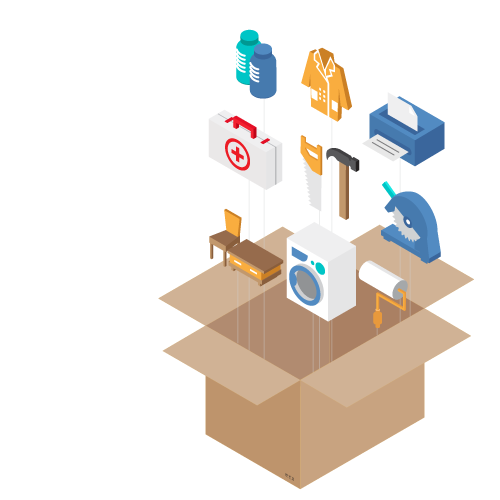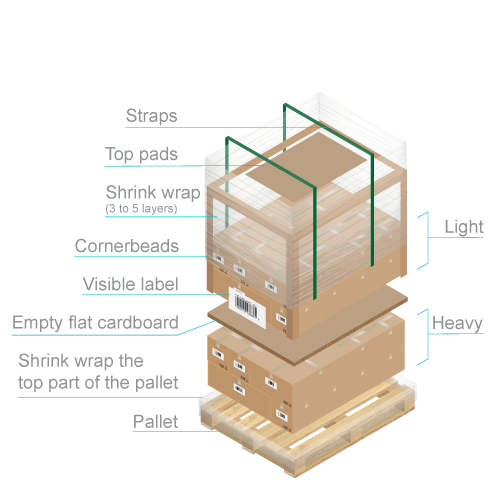How to properly package freight
Prepare your freight for the turmoil of transport by packaging it correctly
Here are a few simple steps you can take to make sure your cargo gets delivered safely and on time.
1. If possible, place your cargo in individual boxes
Having your freight in individual packages will ensure that:
- Your load will be better suited for proper weight distribution
- It will be easier to label each box and make sure that its contents are accounted for. Note that neither Freightera nor our carriers will require this of you, although it is strongly recommended for safety reasons
- Boxes can form specific patterns on the pallet to ensure cargo integrity and stability

2. Fill the boxes with enough padding to protect the items, but not so much that you compromise the integrity of the individual boxes
Most damage in the freight industry occurs due to shock and tremors during transportation caused by bumpy roads, or the movement of cargo inside the truck. That means that shock absorption is a crucial factor in proper freight packaging.
Each box on the pallet should be filled with padding such as crumpled paper, cardboard cutouts, or styrofoam to ensure the goods inside can withstand the process of transportation.
3. Place the cargo onto a pallet
Pallets are the most common type of packaging used in freight transportation. They are cheap, usually recyclable, safe, and easy to maneuver via forklift or pallet jack.
This is the most important step to follow on this list. In most cases, carriers will refuse to pick up your freight if it is improperly packaged. Placing the freight on a pallet is the bare minimum that most carriers require. If your item is not safely strapped to one, carriers may refuse to pick it up due to liability reasons.
Even if your cargo is not of any value, it can pose a threat to other cargo, which means that using a pallet (or skid) is a must when it comes to shipping freight.
4. Arrange the boxes from heaviest to lightest (bottom to top)
In order to ensure maximum stability and minimize the risk of your cargo being crushed under its own weight, arrange the boxes starting with the heaviest ones at the bottom and work your way up to the lightest ones at the top.
5. Place a layer of cardboard between each layer of boxes
Use a layer of cardboard between each box layer. Shock absorption is crucial, and that added layer will provide the extra protection needed for the lower layers of your shipment.
6. Align the boxes as evenly as possible
Properly arranging the boxes on your pallet can drastically increase the integrity of your shipment.
To maximize the protection your boxes provide, make sure to align them as evenly as possible one on top of the other. This has proven to be the most effective pattern in terms of provided protection.
Alternatively, you may align them in a criss-cross pattern similar to that of bricks in walls. That pattern would be the second-strongest possible, although it can be up to 40% weaker than the one shown in the image below.
7. Use (cardboard) corner guards
Freight shifts inside the truck. That’s why you need to make sure that if your cargo comes into contact with any other, it’s well protected. Corner guards will make sure that the most exposed parts of your pallet are well protected in case of shifting or tilting.
8. Use plenty of shrink wrap
Wrapping your boxes (or even single large pieces of cargo) in shrink wrap will make sure that your freight remains together and shifts as little as possible on the pallet.
Use the shrink wrap generously as one or two layers will not be enough. Using it in large quantities will minimize movement, as well as provide that little bit of extra protection that might make a difference between a safe delivery and an insurance claim.
9. Use plastic straps to make sure your cargo is safely fastened to the pallet
Simply placing the cargo onto a pallet is not enough. Odds are, it’s still likely to shift on top of it, and it would be difficult to maneuver via forklift.
That’s why it’s essential to use plastic straps to safely strap the cargo to the pallet to prevent any potential movement.
Use at least three straps on each side of the pallet to make a square or diamond pattern.

10. Correctly place the shipping labels in at least two top-right corners of the pallet
Improper shipment labeling is one of the leading causes of cargo loss. The bare minimum required for any shipment is having at least one label in the top-right corner of the pallet.
We recommend that you place a label on all 4 sides of the shipment to allow visibility of it from as many angles as possible.
Using more than one label will drastically improve the visibility of your shipment.
Make sure that each label is as straight as possible. Any excessive tilt in sticker placement may interfere with scanning or reading.
11. If your cargo is high-value or fragile, use a crate instead
Most articles will be amply protected if you follow the steps above.
However, some cargo such as original pieces of art, or fragile pottery will require additional protection. Wooden or metal crates will be necessary for shipping such items or if you desire the safest packaging option available.
Crates require ample padding inside of them just like boxes as they provide plenty of protection from outside forces, although your cargo can still shift inside the crate and get damaged on the walls.
Filling the crate will be the same process as with boxes, although you don’t have to worry about compromising the integrity of the crate nearly as much.
Crate designs may vary in their ability to protect your cargo or support weight on top of them.
They can be without any additional support on their sides, with one additional support frame, or with two additional support frames forming an X pattern.
From left to right these designs are sorted from weakest to strongest.
To learn more about our services, please check out our pallet shipping page. It contains lots more useful information that is not packaging specific.
If you have any questions, you can chat with us, call our super-friendly Client Care team at (800) 886-4870 Ext. 1 or email us at [email protected].
